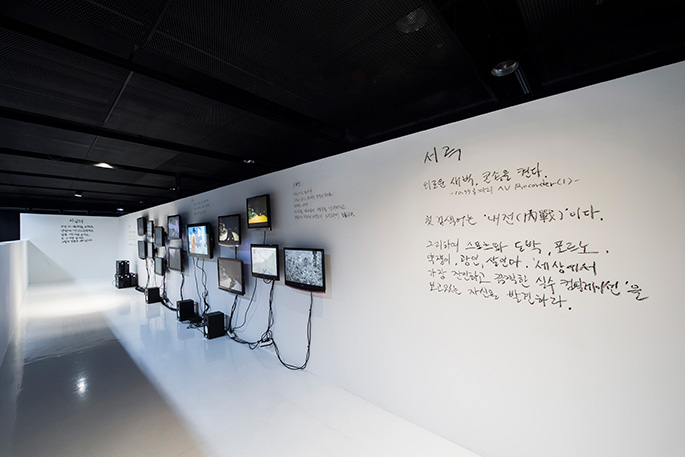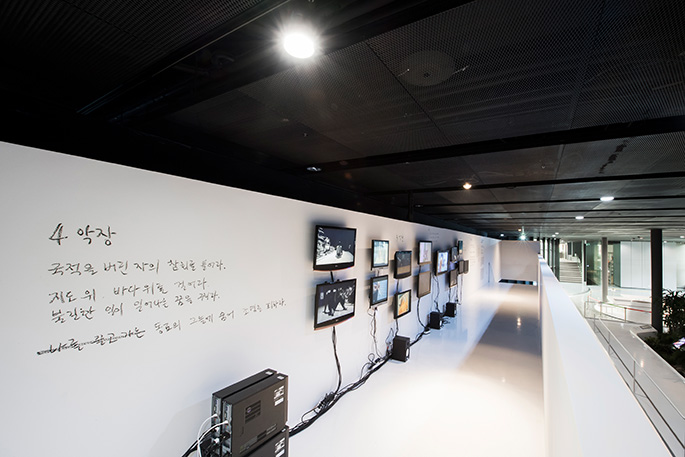
2017.6.27(Tue) – 2018.2.4(Sun)
Nam June Paik ruptured the authoritarianism of music and the auteurism of visual art, by establishing a new relationship with the audience. Extraordinary Phenomenon, Nam June Paik is to explore his works of art from a standpoint of ‘participation.’ The notion of participation in contemporary art has been developing from the interaction between artworks and audiences, to the involvement in social and political institutions through the very interactions woven in and out of art. Way before the discourses of ‘relational aesthetics’ were brought to the fore engaging with institutions and social systems, Paik already put into practice a new form of art that unsettled conventional ways of art production and its reception.
Such graphic scores as Moving Theater, New Ontology of Music, Symphony for 20 Rooms that composer Paik produced in the early 1960s, all postulated active audiences as integral to actually performing the scores. Most works featured in his first solo show Exposition of Music – Electronic Television held in 1963 were also in a state of flux, indeterminate and transformative, depending on the audience’s actions. This seminal event opened up a new chapter of exhibition histories in terms of its innovation in audience interactivity.
In the exhibition, klavier Intégral and Random Access, and also thirteen experimental televisions introduced there for the first time. His intervention in the television, in particular, by modifying and manipulating both TV sets and broadcast images, was geared not only to changing the relationship between artworks and audiences. It was no less than a joint intervention of the artist and the audience alike in the institutional workings of media systems, and a subsequently formulated proposition for new modes of communication could forge a different kind of social and political relations.
Paik’s idea of participation was much broader than the audience’s interaction with works of art; it was a challenge to the institutionalization of music and visual art, and on a more fundamental level, it was an experimental language of art per se. Paik often spelled out his experimentation on the intersection of art and technology like Paik-Abe Video Synthesizer, Robot K-456, and Good Morning Mr. Orwell, in musical terms. Wolfgang Fortner with whom Paik studied composition in his earlier days at Hochschule für Musik Freiburg, once remarked on Paik as “… so extraordinäre Erscheinung wie Paik… .” What Paik enacted marked the beginning of video art and also of a whole different idea of communication in art, carrying the audience into an unprecedented dimension of participation through fracturing canonicity of art. Extraordinary Phenomenon, Nam June Paik will look into the implications of Paik, the ‘extraordinary phenomenon’ in art history.
I
In the normal concert,
the sounds move, the audience sit down.
in my sosaid action music,
the sounds, etc., move, the audience is attacked by me.
-Nam June Paik

This will enable us to shape as
the TV screen canvas
as precisely as Leonardo
as freely as Picasso
as colorfully as Renoire
as profoundly as Mondrian
as violently as Pollock and
as lyrically as Jasper Johns.
-Nam June Paik
Paik-Abe Video Synthesizer is a humble effort for this day, putting 1,001 ways of instant TV making. We gave up High Fidelity but we won the Super Infidelity… adultery is always more interesting than marriage.
-Nam June Paik

Anyway, if you see my TV, please, see it more than 30 minutes.
〔…〕
Don’t expect from my TV: Shock., Expressionism., Romanti-cism., Climax., Surprise., etc…… for which my previous compositions had the honour to be praised. In Galerie Parnass, one bull’s head made more sensation than 13 TV sets . May-be one needs 10 years to be able to perceive delicate difference of 13 different “distortions” (?), as it was so in perceiving the delicate difference of many kinds of “noises” (?) in the field of electronic music.
Participation TV (the one-ness of creator, audience, and critic) is surely one probable way for this goal… and it is not a small virtue… not at all…
-Nam June Paik

Nam June Paik, Nixon TV, 1965/2002, Two 20″ TVs with 2 magnetic coils, Macintosh tube amplifier, switcher
Nam June Paik, Participation TV, 1963/1998, Manipulated television with signal amplifiers and microphone
Nam June Paik, TV Crown, 1965/1999, Color Television manipulated by 2 Audio Generators, 2 Ampliphiers, and a Heat Regulator.
〔…〕 wanted to let the audience act and play itself. I therefore renounced the interpretation of music. I expose the music. I made various kinds of musical instruments, object sonores, to expose them in a room so that the congregation may play them as they please. I am no longer a cook (composer), but only a ‘feinkosthandler’(delicatessen proprietor).
1) These instruments allow me to combine several sensory activities: touching, blowing, caressing, watching, stepping, walking, running, hearing, knocking…
2) They produce a more serene music than all the serene music of the old days and make the room more mobile than all other movable aisles of the old days. A new category can thus be opened which lies between music and architecture. 〔…〕
-Nam June Paik

Good Morning Mr.Orwell of New Year’s Day, 1984, produced all kinds of feedback. Cage and Beuys are friends, but they have never performed together, Beuys and Ginsberg are two artists who have many things in common (active political involvement, heated performance, complete anti-nuclear naturalism, similar age, romanticism.), but have never met. The heavenly stars (Mars, Saturn, Altair, Vega, etc.) meet periodically, but the earthly ones do so very rarely. When I ponder what mysteries the encounter with other people holds for our insubstantial lives, I feel it is a terrible shame that great geniuses may pass their prime without ever meeting.
Interactive things have to be live. We wanted to use interactive TV because the best use of TV is that you talk back to it like a telephone.
-Nam June Paik

I thought of it mostly as a Happening tool. I thought it should meet people in the street and give one second of surprise. Like a quick shower. I wanted it to kick you and then go on. It was a street-music piece. I took the robot with me to the United States in 1965, where it opened the Second Avant-Garde Festival that fall, in Judson Hall. Later I brought it to the streets of New York, to 57th Street, and then Park Avenue, and one sunny Sunday in Washington Square. All the people screamed when they saw the robot coming. One half-crazy black man screamed over and over: “God made this robot.” The happiest moment in my life was when I brought the robot to Washington Square: it was really a big sensation.
-Nam June Paik

In conjunction with Extraordinary Phenomenon, Nam June Paik, artists Yongju Kwon, Eda Kang and Hyunjoon Chang present a project entitled Remaining and Expanding. This is a contemporary reinterpretation of Paik’s Symphony for 20 Rooms(1961) that was all about synaesthetic installations, soundscape of the time, and the music completed and continued by audience participation. The three artists have worked together to create a 2017 score of their own, by looking into Paik’s 1961 score and yet distancing themselves from it. What is woven through their narratives are the contemporary landscape, sounds and actions in which the virtual is intermingled with the real, and the threat of chaos is posed by unrelenting terrorism and wars.

















